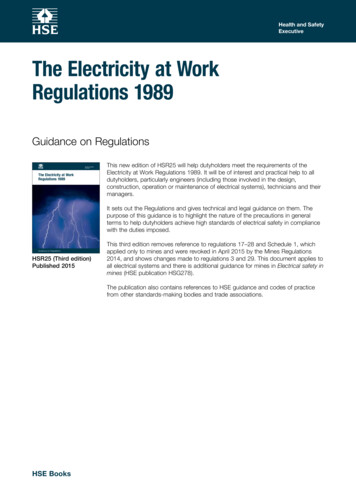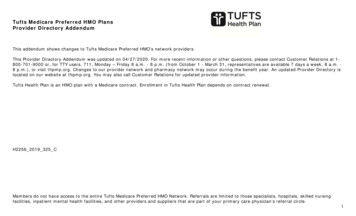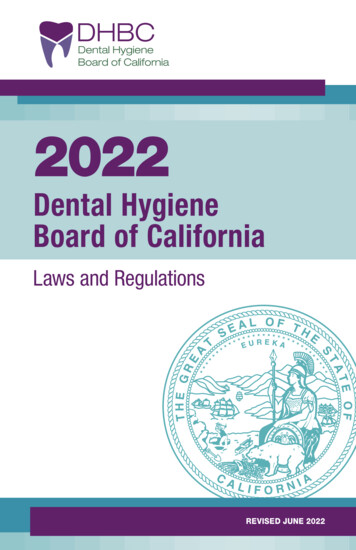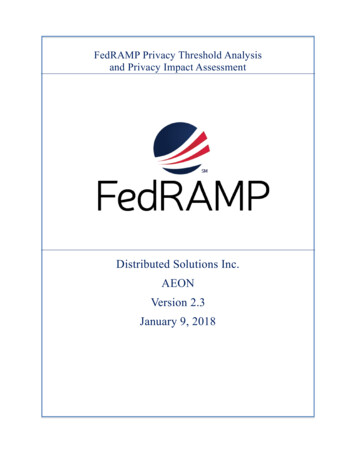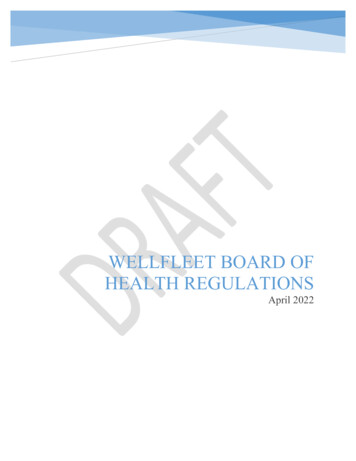
Transcription
WELLFLEET BOARD OFHEALTH REGULATIONSApril 2022
TOWN OF WELLFLEETBOARD OF HEALTH on300Definitions400Regulatory Process and General Provisions500Water Wells600Subsurface Sewage Disposal Systems700Underground Storage Tanks800Swimming Pools900Farm Animals1000 Solid Waste Transfer Station2000Massage/Muscular Therapy2000A Body Art Establishments and Practitioners3000Miscellaneous Regulations4000Tobacco Control Regulations5000State Regulations6000Temporary Regulations7000Procedures8000Fee ScheduleAttachment A Recycling1
TOWN OF WELLFLEETBOARD OF HEALTH REGULATIONSAs amended 03/07/94, 06/15/00, 7/1/01, 11/14/01, 3/27/02, 2/26/03, 3/26/03, 3/22/06, 9/27/06,8/7/08, 4/28/10, 5/26/10, 7/11/12, 11/13/13, 4/9/14, 5/11/16, 10/11/17100INTRODUCTION101The following regulations are promulgated under the authority of the General Laws of theCommonwealth. They supplement those provided by the State Building and SanitaryCodes, and those issued under the Wetlands Protection Act, the Water Pollution ControlAct, the Wellfleet Floodplain Bylaw, and the Wellfleet Environmental Protection Bylaw.The Wellfleet Board of Health Regulations will prevail when they are more restrictive.102The following regulations are designed to protect the public health and safety of theresidents and visitors, and are based on the particular physical, environmental,hydrogeological, and demographic conditions, and land use information and projectionsavailable to the Board as they relate to the Town of Wellfleet. Of specific concern is theneed to protect the groundwater, which is the sole source of our drinking water.103These regulations become effective January 1, 1988 and supercede all previously issuedBoard of Health regulations, except as noted hereinafter.104If any section, paragraph, sentence, clause, phrase or word of these regulations shall bejudged invalid for any reason, that decision shall not affect any other portion of theseregulations which shall remain in full force and effect; and, to this end, the provisions ofthese regulations are hereby declared severable.200 ADMINISTRATION201The Board of Health will make determinations in accordance with these and otherregulations, but reserves the right in special circumstances, as determined in its judgment,to be more restrictive, to issue variances, or to grant exemptions. The rationale for suchdepartures shall be documented in written minutes of the Board of Health meeting inquestion.202The Health Agent is authorized to act for the Board of Health (1) when an applicant hasclearly met all State and Wellfleet requirements, and (2) in emergency situations. At itsnext posted meeting, the Board of Health is required to ratify or modify as necessary inits judgment, the actions taken and/or decisions made by the Health Agent in suchemergency situations.DEFINITIONS300With the exceptions listed in 302, the definitions provided in the State Building andSanitary Codes and the Wetlands Protection Regulations will apply. “Board” shall meanthe Wellfleet Board of Health.2
301The following definitions are adopted by the Board for use in administering theseregulations and interpreting State laws, regulations and codes.ABUTTERS Owners of all adjacent properties and properties directly across anypublic or private highway, road, street or way.ALTERATIONTo make different by changing, adding and/or subtractingcomponents, piping, and/or location.BEDROOM A room providing privacy, intended primarily for sleeping, andconsisting of all of the following:(a)floor space of no less than 70 square feet(b)for new construction or existing houses and mobile homes a ceiling heightof no less than 7’0”(c)an electrical service and ventilation, and with regard to new construction atleast one building code conforming egress window.The following are not considered bedrooms:Any “pass through” room that does not afford privacy, a living room or “great”room, a dining room, kitchens, halls, bathrooms, unfinished cellars, unheatedstorage areas over garages, and loft spaces less than 70 square feet. Any extrarooms (such as a finished basement or playroom with building conforming egress)may be considered a bedroom if it meets the definition. For new construction,proposed renovation, alteration or replacement of structure, conformity todefinition criteria is expected; for existing developments, criteria will be applied incontext of the vintage of construction. In determining proper design flow wherethere is no corroborating record of a grandfathered number of bedrooms on file inthe Health Department, the calculation will be derived only from presently existingbedrooms in instances where the Nitrogen Loading Limitation is exceeded. Deedrestrictions will be required if maximum bedroom allotment is met and homeownerwishes to finish rooms that may appear to meet the definition above.BUILDABLE UPLANDWetlandThe area of contiguous upland on a lot exclusive ofFAILED SYSTEM A failed system is defined as one in which there is evidenceof sewage flow or ponding to the surface; evidence of overload of the system; anycesspool as defined in Title 5; the system is in such a state of disrepair that it cannot function as originally intended; lack of four (4) foot of vertical separationbetween the bottom of the system and adjusted groundwater (for a 1978 codesystem) or a lack of five(5) foot of vertical separation between the bottom of thesystem and adjusted groundwater (for a 1995 code system); system is composed ofleach pit(s) which is inadequate in design or capacity for the existing use; or systemrequires pumping more than four (4) times in a twelve-month period to preventsuch overflows.3
FILLED LAND Land whose elevation is being, or has been, raised within the pastfifty years by the addition of fill or spoil on the preexisting natural grade.GRANDFATHERED NON-CONFORMING DWELLING An existing habitable dwelling witha design flow rate that exceeds the nitrogen loading limitations.MOUNDING Raising the natural elevation or grade of the ground to cover thecomponents of a sewage disposal system, and/or to meet the vertical distancerequirements above groundwater.NEW CONSTRUCTION The construction of a new building for which anoccupancy permit is required or an increase in the actual or design flow to anysystem or an increase in the actual or design flow to any nonconforming system oran increase in the design flow to any system above the existing approved capacity.NITROGEN LOADING LIMITATIONS The 440 gallons per day per acre nitrogenloading limitations for design of septic systems in Nitrogen Sensitive Areas asdesignated in Title 5.NITROGEN SENSITIVE AREAS: Interim Wellhead Protection Areas andDepartment approved Zone IIs of public water supplies; or Nitrogen sensitiveembayments as identified by the Massachusetts Estuaries Project; or other areaswhich are designated as nitrogen sensitive for purposes of 310 CMR 15.000.NON CONFORMING SYSTEM Any system which, when installed did notcomply with the provisions of either the 1978 or 1995 iterations of Title 5, includingcesspools and all similar systems in use prior to adoption of these codes and withouta signed/stamped engineered planREPAIR To restore to the original condition in the original location by replacingand/or putting together what is damaged or broken.UPGRADE To alter in such a fashion as to improve performance over that of thesystem as originally installed.WATER COURSE A water course shall be defined as a river or spring; a naturalchannel in which water flows regularly or intermittently; a wetland, vernal pool,lake, pond, or dam into which, or from which, water flows.WETLAND Any area that contains swamp, bog, dry bog, fresh or salt marsh,areas of exposed groundwater, embayment’s, rivers, ponds, streams, inland banks,coastal banks, and coastal dunes, or any other area subject to the jurisdiction of theConservation Commission as defined in M.G.L. c. 131, Section 40, 310 CMR10.00, the Wellfleet Conservation Bylaw and the Wellfleet EnvironmentalProtection Regulations excluding the bufferzone and the Area of CriticalEnvironmental Concern.400REGULATORY PROCESS AND GENERAL PROVISIONS4
401Any project which creates additional bedrooms or commercial space through newconstruction or by alteration of an existing structure and changes of use of an existingproperty, must meet both the State Sanitary Code and Wellfleet Board of HealthRegulations.402Plans prepared by a Registered Engineer or by a Registered Sanitarian are required by theBoard for consideration of any project or change requiring Board approval.403Board of Health Well and Disposal Works (Septic System) Construction Permits shallexpire three (3) years from date of final variance approval. Any approvals ofvariancesgranted by the Wellfleet Board of Health are deemed a contract under whichthe applicant must perform the upgrade or new construction as proposed. Any failure toexecute the plans in a timely manner under the Disposal Works Construction Permitwill result in the expiration of variance approvals and enforcement notice to file a revisedplan compliant with any new Title 5 or local regulations that have come into effect.404The following regulation shall apply to all proposed projects comprising six or moredwelling units (existing and/or new) such as hotels, motels, cluster developments,planned developments, subdivisions, nursing homes, and hospitals. Any developer whoseeks to discharge septic system effluent to the groundwater from any of the above typesof development shall be required to obtain Board approval to do so. A preliminarydiscussion with the Board of health is recommended to define the specific informationneeded by the Board in each situation. In the application for Board approval, theinformation listed below will generally be required:A.B.C.D.A water table contour map and geological description of the area in thevicinity of the proposed project, depicting groundwater flow direction.Projections of nitrogen levels in down-gradient groundwater anddelineation of effluent plumes.Projection of the impact on down-gradient water supplies (both present andpotential), lakes, ponds, marshlands, estuaries and coastal waters.Appropriate water quality information.The information provided to the Board must demonstrate that no significant impact todown-gradient water resources will occur as a result of the project.500WATER WELLS501A water supply considered acceptable in quality and quantity by the Board of Health is aprerequisite for any project or change requiring Board of Health permission. A watersupply shall be deemed acceptable in quality if sodium is not greater than 2000mg/l,nitrate/nitrogen is not greater than 10 mg/l, coliform does not exceed zero and all EPAstandards are met.502If a previous water test is on file and has tested above the allowable limits the Boardreserves the right to require a retest at its discretion.5
503No well is to be installed without prior issuance of a Board of Health permit. Replacementwells are not excepted. Within seven days after installation, a “Well Construction Record”is to be submitted by the installer to the Board of Health on the form provided.504Private water wells are to be located on the property served.505Water wells for new construction of private residences are to be located at least 100 feetfrom any cesspool or septic system leach field, and at least 50 feet from any catch basinserving a paved area. To the extent feasible, replacement wells are to meet the samecriteria. In any event, replacement wells are not to be located closer to the nearest cesspoolor septic system leach field than the well being replaced.506For new construction, water well completion reports must be provided to the Board beforea sewage disposal works permit will be issued. Such reports will locate the well installationaccurately on the plot plan of the property, and describe the physical characteristics of thewell, for example, by providing a well log.507Only well-drillers licensed by the Commonwealth of Massachusetts may install wellswhich are to provide water for drinking purposes, irrigation or monitoring.508A water sample shall be obtained from all drinking wells requiring a permit for analysis bythe Barnstable County Health Department or by a State-certified laboratory. The testingshall include as a minimum (1) coliform count, (2) pH, (3) conductivity, (4) iron content,(5) nitrate content, and (6) sodium content. A copy of the analysis report shall be furnishedto the Board of Health.509Whereas there is evidence that the groundwater in the vicinity of the Wellfleet Landfillcontains substances which are injurious to human health in the judgment of the Board ofHealth, and whereas the Board of Health has a responsibility to protect the health of thosewho obtain their domestic water supplies from such ground waters, and whereas the Cole’sNeck public water supply has been installed whose primary purpose is to prevent anypotential health problems arising from the use of such waters, therefore it is prohibited toinstall and/or use drinking water wells in the Cole’s Neck Area to be Served (ATBS) asdefined in the Cole’s Neck Regulations as adopted November 26, 1990 and amended May7, 1991 and September 24, 2001.510a) When a property is sold or transferred, a standard water quality test is required by theseller, and a copy is to be provided to the Health Department.b) Prior to Board of Health signoff on any Certificate of Occupancy, a standard waterquality test taken within one year of the request for Certificate of Occupancy and meetingthe Federal Drinking Water Standards is required.c) Prior to issuance of any Disposal Works Construction Permit, a standard water qualitytest taken within one year and meeting the Federal Drinking Water Standards is required.6
511It shall be unlawful for a commercial entity to employ the use of non-recycled waterdependent displays of merchandise.512Bottled water permits will not be allowed for new food service establishments.600SUBSURFACE SEWAGE DISPOSAL SYSTEMS601Required Upgrades: In order to improve the quality of water for the Town of Wellfleetelimination of septic systems which meet the failure criteria by Title 5 and the Local BOHRegulation definition of failure shall bring nonconforming septic systems into compliance byupgrading them to meet the standards of this section and/ or Title 5 in the following situations:A. Prior to any sale or transfer of title to the facility served by the system;B. Prior to any change of use or increase in design flow;C. Prior to the subdivision or partitioning of a parcel of land on which a nonconforming septicsystem is located;D. If the system demonstrates any of the characteristics of a failed system as defined by theseregulations and/ or Title 5E. If the septic system serving the facility was not constructed according to an approvedstamped plan (i.e. Plan shows distribution box but it is not in the plan);F. If the system does not meet the design flow of the facility it serves;G. If a facility is replaced, relocated, or demolished;H. The liquid depth in a leach pit is less than six inches from the inlet pipe invert or theremaining available volume within a leach pit above the liquid depth is less than ½ of oneday’s design flow;I. All non-conforming septic systems and cesspools within two hundred (200) feet of anywetland or within the floodplain as mapped by FEMAJ. Cesspools in Wellfleet are herein defined as failed systems and shall be uipgraded to meet therequirements of Title 5 prior to December 31, 2024. All new systems replacing cesspoolsshall be installed and issued certificates of compliance by December 31, 2024.602Multiple Systems on One Lot: In the event of the failure of one septic system on a lot that has morethan one non-conforming septic system, the failing system shall be immediately upgraded and theremaining non-conforming septic system shall also be upgraded to meet the requirements of the1995 Title 5 code and these regulations within one years’ time. If the design flow for the facilityis over 2000 gallons per day, pressure distribution must be used.603Sewage Disposal Works Construction Permits will be issued when the proposed systemfully meets the physical (i.e. hardware and spatial) requirements of the State Sanitary Code (Title5), and the following specific requirements of the Wellfleet Board of Health:A.The leaching field must be at least 100 feet, and the septic tank at least 50 feet, fromany water-course.7
B.C.D.E.604The septic tank and the leaching facility must be at least 1 foot below the existingnatural grade when in the 100 year floodplain.A minimum 1500 gallon septic tank is required for single family dwelling units.Inspection and approval by the Board of Health or its Agent at the time ofinstallation is required by the Board.The applicant must provide evidence that the property to be served by the systemhas an acceptable water supply before a Sewage Disposal Works ConstructionPermit will be issued.“As-Built” cards must be filed with the Health Agent prior to final inspection of thesystem by the contractor. The Board of Health requires certified As-Built plans by theengineer. As-Built cards or plans must accurately depict the installed locations of systemcomponents.605 INSPECTION CRITERIAUnless inspected previously within two years under the terms of this regulation, the on-sitesewage disposal system shall be inspected by a licensed inspector approved by theBoard of Health whenever a property containing such a system is transferred bysale, exchange, gift, or bequest to a new ownership, or placed into or taken out of a formoftrust ownership;Where there is an application for a special permit that allows usesnot otherwise permitted by the Wellfleet Zonong Bylaws; Any changes of use in a property;Application for a new license or transfer of an existing license, renewal of the annualoperating permit for the operation of a motel, cottage colony, cabins, campgrounds, lodginghouses and restaurants. A copy of the report of such inspection is to be furnished to theHealth Department by the prospective new owner prior to the closing, and where anupgrade is required, an agreement specifying the timeframe shall be signed.Where there is an application for a building permit proposing renovation, replacement oralteration of habitable or accessory area, footprint, or making improvements to structurebeyond minimal expense, a septic inspection will be required to determine if an upgrade isneeded. A copy of the report of such inspection is to be furnished to the Health Departmentby the permit applicant prior to the Health Agent’s approval for any building permit.Exemptions from this provision are involuntary repairs necessary to maintain structuralintegrity or minimum standards of habitation, such as framing, window and roofing repairs/ replacements or evidence in Health Department files that the septic system was installedwithin the past ten years, according to the date of the building permit.In addition to the inspection criteria set forth in Title 5, the following criteria shall beobserved in conducting system inspections:A. An open inspection of all components of the system. If a component can not be foundor uncovered after a reasonable search, the inspector must provide evidence for thesystem’s success or failure. Replacement or installation of the component is requiredin this instance.B. The septic tank shall be pumped at the time of inspection if it has not been pumpedwithin the past three years.8
C. Leach pits must have 6 inches of leaching capacity below the outlet invert in order topass the inspection. The 6 inches of leaching capacity is determined by clean sidewallabsent of staining or evidence of high water.D. The inspector must clearly indicate on the inspection form the height of standingliquid and the level of staining in any leaching component, and the description of bothsanitary tees in any inspected tank.E. Any work for correction of component failures must be done under benefit of adisposal works construction permit.F. If the inspector finds that access ports/ inspection port covers are not within six inchesof grade, risers shall be provided and installed and shall be indicated on the inspectionreport submitted.G. Vertical separation to groundwater shall be confirmed and measured in in the fieldand documented on the Title 5 inspection report. The groundwater adjustment shallalso be evaluated and shown on the report.The Health Department shall promptly evaluate all such inspection reports received anddetermine whether or not it requires, within six (6) months from the date of closing orwithin two years from the date of issuance of any building permit, an upgrade of saiddisposal system to meet Title 5 and Town regulations to the extent feasible. A system thatpasses inspection shall be deemed to have met the standards of Title 5 that were in placewhen the system was permitted, with the exclusion of vertical separation to groundwaterstandards that may have existed prior to the 1978 version of the Title 5 code.In making its determination, the Health Department and the Board of Health shall considerthe following:(1) vertical separation between the bottom of the leaching facility and adjustedobserved groundwater meets the minimum of 4 feet for existing 1978 code systemsand 5 feet for 1995 code systems,(2) setbacks to septic systems and wells in the neighborhood,(3) setbacks to wetlands and local requirements for denitrification,(4) evidence of overflow, hydraulic loading, breakout, filling, or a deviation fromthe approved plan,(6) pumping records,(7) leaching capacity of existing systems relative to potential need.(8) Nitrogen loading on pre-existing nonconforming lotsThis regulation shall not be effective at the conveyance or device of the property to thesurviving spouse or, in the case of joint ownership, if the property is conveyed to one ofthe original owners.Under these local regulations, a cesspool system serving any property shall be defined as“failed” and must be upgraded to meet Title 5 standards within 6 months of propertytransfers of any device, and within two years of the issuance of a building permit, or anyself-identification associated with a septic inspection or by December 31, 2024.9
Systems that have been previously determined to be failed and are under enforcementfrom the Board of Health must be upgraded prior to property transfer or money toaccommodate such upgrade shall be placed into an escrow account. The Board of Healthmust be provided written evidence of such account. The upgrade must take place within30 days of property transfer.606The addition or application of any chemical or biological agent for the purpose ofcleansing or rejuvenating on-site cesspools or septic systems is prohibited except whereapproved by the DEP.607Systems judged by the Health Agent to have failed must be upgraded to meet existingState and local requirements. Systems that are a threat to the public health must berepaired immediately.608Required Setbacks for System ComponentsNotwithstanding the provisions of 310 CMR 15.00 all systems shall conform to thefollowing minimum setback distances for septic tanks and soil absorption systems (SAS),including reserve areas, as measured in feet and set forth below:Septic Tank or Pump ChamberSASSurface Water (excluding Wetlands)Wetlands (including Floodplains)Pondsmaximum distance available50’100’100’100’150’150’or greatest609Innovative/ Alternative TechnologyThe use of a nitrogen reducing system (Nitrogen reducing systems are defined as those systemstechnologies approved by MADEP and rated at 19 mg/liter nitrogen) is required when thereis:A.B.C.D.E.F.G.a variance to the required 100 feet separation between a drinking water supply welland a soil absorption system,when a soil absorption system is located less than 100 feet from any wetland resourceareafor nitrogen credit applicationsfor upgrade of non-conforming systems as determined by the Board of Healthfor upgrades of previously approved systems that exceed current nitrogen loadingstandards of 110 gpd/10,000 square feet of lot areaIn Nitrogen Sensitive Areas as determined by MA Estuaries Projectin certain cases where a variance is required and circumstances support the use ofI/A to mitigate the environmental impact of the proposed system, as determined bythe Board of Health10
H. for all new construction, repairs, all property transfers and upgrades within theWellfleet Harbor Embayment System watersheds as identified by the MassachusettsEstuaries Project (MEP) report (2017).The use of an Enhanced nitrogen reducing system (those technologies that have average nitrogeneffluent concentrations less than 10 mg/liter or demonstrate a net average nitrogen removal rateof 75% or greater as demonstrated by third-party testing) is required when:A. Compliance with nitrogren loading limitations cannot be met and the loading rateexceeds 440 gpd/acreB. for all new construction, repairs, all property transfers and upgrades within theWellfleet Harbor Embayment System watersheds as identified by the MassachusettsEstuaries Project (MEP) report (2017).Variances to this section may take into account the following mitigating factors:direction of groundwater flow, topography, soil conditions, well depths, waterquantity/availability, water quality of the locus and surrounding lots, and feasible location ofstructure and septic system.Any property served by an innovative/alternative or enhanced system, or recirculating sand filtersystem approved by the Board of Health shall have notice of the presence of this system recordedon the property deed at Barnstable County Registry of Deeds.Non-Performance of Innovatione/Alternative and Enhaned Technology SystemsA. Non-performance includes any system that has been determined to be failing toprotect public health and safety and the environment, or a system with equipmentfailure or an unresolved alarm event, or components that are not functioning asdesigned, or components that are not functioning in accordance with manufacturersspecifications, or a system that is in violation of the terms of the its approval from theBoard of Health.B. Non-performace requires written notification to the Board of Health within 1 weekfrom receipt of a lab result, along with a remediation plan with outlined correctiveactions to be taken.C. Corrective actions must be taken within two weeks of BOH notification to addressperformance that does not meet the standards of approval.D. Lab results showing an exceedance of TN triggers a retest following the correctiveactions to demonstrate that the system is back in compliance with applicablestandards.E. Failure to comply with this process may result in a written warning from the HealthDepartment followed by possible fines and a hearing with the Board of Health thatmust be attended by the property owner and licensed inspector.11
610As allowed under M.G.L. Ch. 111 sec. 31, the Board of Health of the Town of Wellfleethereby requires that owners and operators of all innovative/alternative sewage treatmenttechnologies and all systems where the soil absorption system is designed for pressuredistribution of effluent must report the results of all operation, maintenance, andmonitoring activities to Barnstable County Department of Health and Environment. Suchreporting must be performed in the manner specified by Barnstable County Departmentof Health and Environment and must occur within 30 days after each maintenance ormonitoring event. Further, when a system operator performs a system inspection andfinds that a sewage treatment technology has malfunctioning components which havecompromised the system’s ability to treat sewage as designed, the operator shall report onthe system’s status and any planned corrective actions to the Board of Health andBarnstable County Department of Health and Environment within 48 hours of inspection.611In order to specifically apply the nitrogen loading limitations of 310 CMR 15.214(1) toland area available for recharge, the Board of Health shall only consider buildableuplandin order to calculate nitrogen loading limitations.612Tight tanks will not be permitted when it is feasible to site and construct a Title 5 compliantupgrade for a seasonal or year round residential structure. Tight tanks will only bepermitted when the Board of Health determines that a sufficiently compliant Title 5 systemis not feasible due to excessive variances from state and local regulation.700UNDERGROUND STORAGE TANKSUnderground tanks used for the storage of gasoline, fuel oil, diesel oil, kerosene, antifreeze,chemicals and other toxic liquids represent a major threat of contamination to thegroundwater. The owner of a storage tank that leaks or overflows, and the owner of theproperty on which it is located, are responsible for cost of decontamination and arepotentially liable for any damages resulting from such occurrences. These costs can bevery substantial. It is the intent of these regulations to minimize the threat of groundwatercontamination from underground storage tanks. Any person having first knowledge ofsignificant leaks or spills of the above-mentioned liquids is required to report the matterimmediately to the Board of Health. Guidelines, which are part of these regulations, areavailable from the Board of Health for reference by persons affected by these regulations.These guidelines will be used by the Board in administering these regulations and are basedon the Barnstable County Health and Environmental Department Model UndergroundStorage Tank Regulations and associated backup material.701Owners of any such underground storage tank on their property, the primary purpose ofwhich is to serve the needs of a private residence or business, are required to remove saidtank(s) by December 31, 1997.702Installation of underground gasoline, fuel and
Whereas 5.8% of Massachusetts youth currently use e-cigarettes and 15.9% have tried them; 19. Whereas the Massachusetts Department of Environmental Protection has classified liquid nicotine in any amount as an "acutely hazardous waste"; 20. Whereas in a lab analysis conducted by the FDA, electronic cigarette cartridges that were labeled


